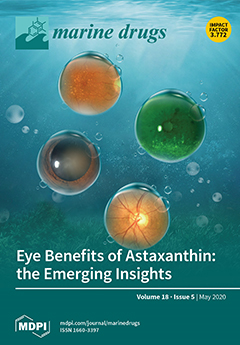A new pentaketide derivative, penilactonol A (
1), and two new hydroxyphenylacetic acid derivatives, (2’
R)-stachyline B (
2) and (2’
R)-westerdijkin A (
3), together with five known metabolites, bisabolane-type sesquiterpenoids
4–
6 and meroterpenoids
7
[...] Read more.
A new pentaketide derivative, penilactonol A (
1), and two new hydroxyphenylacetic acid derivatives, (2’
R)-stachyline B (
2) and (2’
R)-westerdijkin A (
3), together with five known metabolites, bisabolane-type sesquiterpenoids
4–
6 and meroterpenoids
7 and
8, were isolated from the solid culture of a marine alga-associated fungus
Penicillium chrysogenum LD-201810. Their structures were elucidated based on extensive spectroscopic analyses, including 1D/2D NMR and high resolution electrospray ionization mass spectra (HRESIMS). The absolute configurations of the stereogenic carbons in
1 were determined by the (Mo
2(OAc)
4)-induced circular dichroism (CD) and comparison of the calculated and experimental electronic circular dichroism (ECD) spectra, while the absolute configuration of the stereogenic carbon in
2 was established using single-crystal X-ray diffraction analysis. Compounds
2 and
3 adapt the 2’
R-configuration as compared to known hydroxyphenylacetic acid-derived and
O-prenylated natural products. The cytotoxicity of
1–
8 against human carcinoma cell lines (A549, BT-549, HeLa, HepG2, MCF-7, and THP-1) was evaluated. Compound
3 exhibited cytotoxicity to the HepG2 cell line with an IC
50 value of 22.0 μM. Furthermore,
5 showed considerable activities against A549 and THP-1 cell lines with IC
50 values of 21.2 and 18.2 μM, respectively.
Full article






